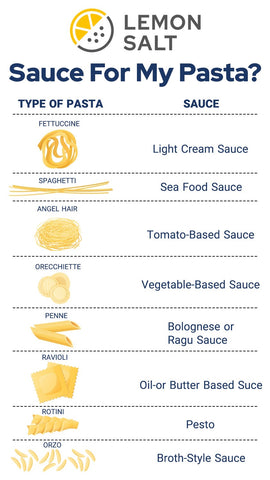
How to choose the right shape pasta for your sauce
Which pasta should I use with which sauce?
You may not know it but there are over 350 different pasta shapes, each created specifically to hold the sauce it’s served with and create the best taste combination.
In Italy many regions have created their own pasta shapes: for example, trofie (perfect with pesto) are from Liguria, and orecchiette (or, ‘little ears’) are from Puglia, bigoli (thick, noodle-like spaghetti) are from Veneto and strozzapreti (meaning, ‘priest strangler’) are from Emilia-Romagna.
So how do you know which pasta to choose to go with which sauce? Well a quick rule of thumb is to pair thinner, cream-based, seafood or oil based sauces with fine shapes such as linguine and richer more robust meaty and tomato sauces with the larger shapes such as conchiglie.
By choosing the correct shape you will ensure the perfect ratio of pasta to sauce in each mouthful thereby creating the perfect taste sensation. Interestingly most Italians would never serve spaghetti with Bolognese which is reserved for larger shapes such as rigatoni.
Our quick guide for Pasta & Sauce selection
Butter or Oil
If you’re using a simple butter or oil dressing for your meal the best pasta to use is thin and delicate - long cuts of pasta capellini, thin spaghetti, linguine, Fusilli, lunghi, bucatini, and vermicelli.
Cream
For creamier pasta sauces head for the more robust pasta shapes such as cavatappi, elbows, farfalle, fettuccine, shells, and linguine which will hold the sauce within the nooks of the shape.
Meat or Ragú
A typical meaty sauces or ragùs such as Bolognese are best served with traditional tube-shaped pasta—like Rigatoni, Bucatini, Pappardelle, Conchiiglie, lumache, and Orecchiette.
Pesto
This fresh and fragrant pasta sauce is served uncooked, so you need to choose a pasta shape that won’t overwhelm it. Pesto is therefore served best with longer cuts of pasta, like the corkscrew shape of Fusilli, Bucatini, Capellini, thinner Spaghettini, and Fettuccine.

How to cook pasta
- Use a very large pan of salted, boiling water. If you don’t give the pasta enough space to move, it will stick together. Italians say the water should be as salty as the sea to flavour the pasta.
- If you follow step 1 there is no need to add olive oil to your pasta when cooking
- Always combine the pasta and sauce in the pan before serving to ensure every piece of pasta is coated.
- Don’t cook the pasta all the way. Instead, drain it when it still has a little bite, then add to the sauce and continue cooking for a few minutes more until it is cooked al dente and has absorbed a little of the sauce.
- When draining the pasta, save a small cup of the water. Then, when you add the pasta to the sauce, splash in a little of the water if it looks too dry. The starch in the water will help the sauce cling to the pasta.

Leave a comment